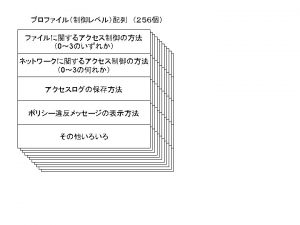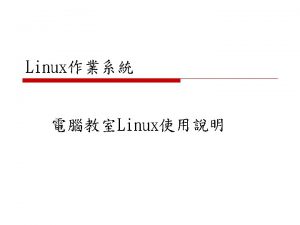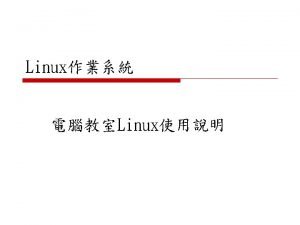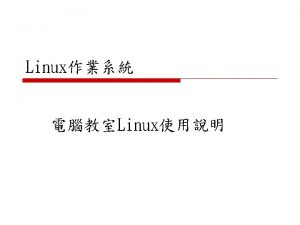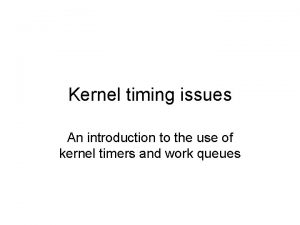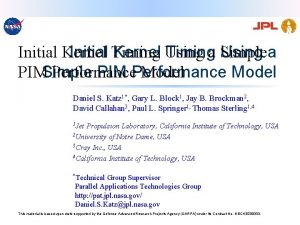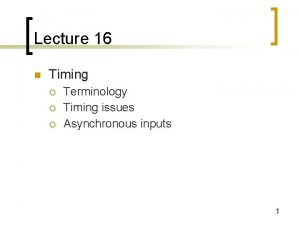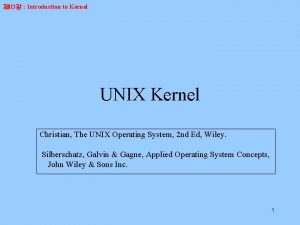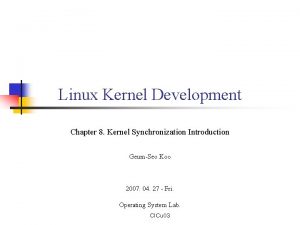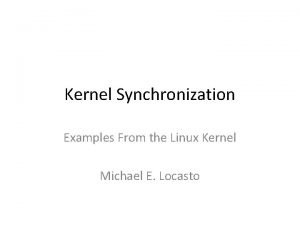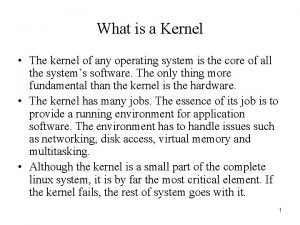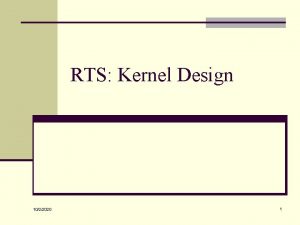Kernel timing issues An introduction to the use



























- Slides: 27

Kernel timing issues An introduction to the use of kernel timers and work queues By Allan Cruise http: //www. cs. usfca. edu/~cruse/cs 635 f 07/ modified by sdc

Kernel timers • Linux offers a facility that lets drivers put a process to sleep until a fixed amount of time has elapsed (as measured in jiffies) • When the timer expires, a driver-defined action will be performed, which can ‘wake up’ the process that was put to sleep, or could perform some alternative action (for example, the kernel timer could re-start)

jiffies • • unsigned long volatile jiffies; global kernel variable (used by scheduler) initialized to zero when system reboots gets incremented during a timer interrupt so it counts ‘clock-ticks’ since cpu restart ‘tick-frequency’ is a ‘configuration’ option On our machines: HZ=250 (in ‘. config’)

jiffies overflow • Won’t overflow for at least 16 months • Linux kernel got modified to ‘fix’ overflow • Now the declaration is in ‘linux/jiffies. h’: unsigned long jiffies_64; and a new instruction in ‘do_timer()’ (*(u 64*)&jiffies_64)++; which compiles to assembly language as add $1, jiffies+0 adc $0, jiffies+4

Kernel timer syntax • Declare a timer: struct timer_list mytimer; • Initialize this timer: init_timer( &mytimer ); mytimer. func = mytimeraction; mytimer. data = (unsigned long)mydata; mytimer. expires = <number-of-jiffies> • Install this timer: add_timer( &mytimer ); • Modify this timer: mod_timer( &mytimer, <jifs> ); • Delete this timer: del_timer( &mytimer ); • Delete it safely: del_timer_sync( &mytimer);

A kernel-timer caution • A kernel timer’s timeout-action cannot do anything that could cause the current task to ‘sleep’ (such as copying data between user-space and kernel-space, or trying to allocate more kernel memory) • However, to aid debugging, a timer CAN use ‘printk()’ within its timeout-routine

‘trytimer. c’ • We have posted an example that shows how a Linux kernel timer can be used to perform a periodic action (such as using ‘printk()’ to issue a message every time the time expires, then restart the timer • Notice that our demo is not able to issue messages directly to the console – its timer-function executes without a ‘tty’

Delaying work • If a device-driver needs to perform actions that require using process resources (like a tty), or that may possibly ‘sleep’, then it can defer that work – using a ‘workqueue’

Programming syntax • Declare: struct workqueue_struct *myqueue; struct work_struct thework; • Define: void dowork( void *data ) { /* actions */ }; • Initialize: myqueue = create_singlethread_workqueue( “mywork” ); INIT_WORK( &thework, dowork, <data-pointer> ); • Schedule: queue_dalayed_work( myqueue, &thework, <delay> ); • Cleanup: if ( !cancel_delayed_work( &thework ) ) flush_workqueue( myqueue ); destroy_workqueue( myqueue );

‘tryworkq. c’ and ‘defermsg. c’ • We have posted demo-modules that show the use of workqueues to perform actions later, either as soon as a ‘process context’ is available, or after a prescribed time • Further details on the options for using an existing kernel workqueue or a workqueue of your own creation may be found in our textbook (Chapter 7 of LDD 3) http: //lwn. net/images/pdf/LDD 3/

Applying these ideas • To demonstrate a programming situation in which using kernel timers is valuable, we created the ‘foo. c’ device-driver, plus an application that uses it (‘watchfoo. cpp’) • You can compile and install the module, then execute the application: $ watchfoo • But you will notice there are two ‘problems’ (excess cpu usage and loop-termination)

Reducing CPU’s usage • The ‘watchfoo’ program rereads ‘/dev/foo’ constantly (numerous times per second), much faster than the human eye can see • If you run the ‘top’ utility, you will see that a high percentage of the available CPU time is being consumed by ‘watchfoo’ • You can add a kernel timer to the ‘foo. c’ driver to curtail this excessive reading

In-class exercise • Modify ‘foo. c’ (call it ‘timedfoo. c’) as follows • Create an integer flag-variable (‘ready’) as a global object in your module • When your ‘read()’ function gets called, it should sleep until ‘ready’ equals TRUE; it should set ‘ready’ equal to FALSE when it awakens, but should set a timer to expire after 1/10 seconds • Your timer’s action-function should set ‘ready’ back to TRUE, then wake up any sleeping tasks

Implementation hints • You need a wait-queue (so your driver’s ‘reader’ tasks can sleep on it) • You need a timer action-function • You need to organize your timer-function’s data-items into a single structure (because the timer-function has only one argument) • Your timer-function must do two things: – Change ‘ready’ to TRUE – Wake up any ‘sleepers’

Deferring work • Linux supports a ‘workqueue’ mechanism which allows the kernel to defer specified work until some later point in time • This mechanism has been ‘reworked’ in a major way since our texts were published • So any device-driver has to be modified if it made any use of a kernel ‘workqueue’ • Changes require grasp of some ‘macros’

• #include <linux/workqueue. h> • void dowork( struct work_struct *data ); • DECLARE_DELAYED_WORK( mywork, dowork ); • struct workqueue_struct *myqueue; • myqueue = create_singlethread_workqueue( “mywork” );

‘workqueue’ syntax #include <linux/workqueue. h> struct workqueue_struct *myqueue; // pointer to your workqueue void dowork( struct work_struct *data ); // your function’s prototype DECLARE_DELAYED_WORK( mywork, dowork ); int init_module( void ) { myqueue = create_singlethread_workqueue( “mywork” ); if ( !queue_delayed_work( myqueue, &mywork, HZ*5 ) ) return –EBUSY; return 0; // SUCCESS } void cleanup_module( void ) { destroy_workqueue( myqueue ); }

‘tryworkq. c’ In this example the delayed work consists of simply printing a message to the kernel’s logfile -- you can view by typing the ‘dmesg’ command void dowork( struct work_struct *data ) { printk( “nn I am doing the delayed work right now n” ); } Notice that the ‘action’ function in this example ignores its ‘data’ argument

An improved example • Our ‘announce. c’ module shows how an LKM could display its messages within a window on the Linux graphical desktop • It uses the ‘tty_struct’ object which exists in the process-descriptor for the ‘insmod’ task which you launch to install the LKM • We shall see how this same idea can be used in a waitqueue’s ‘action’ functions

‘timer’ verses ‘workqueue’ • Any kernel-timer’s action-function will be executed in ‘atomic’ context – just like an interrupt service routine: it cannot ‘sleep’, and it cannot access any user-space data • But any workqueue’s action-function will be executed by a kernel-thread – and thus it possesses a ‘process’ context, so it can be ‘scheduled’ and ‘sleep’ if necessary – though it, too, cannot access user-space

If ‘dowork()’ needs data… // data items needed by your ‘dowork’ function are packaged in a ‘struct’ struct mydata { char *msg; struct tty_struct *tty; } my_data = { “n. Hellon”, NULL }; // your module-initialization function sets up your ‘struct delayed_work’ object // and it can also finish initializing your ‘my_data’ object’s member-fields myqueue = create_singlethread_workqueue( “mywork” ); INIT_DELAYED_WORK( &mywork, dowork ); my_data. tty = current->signal->tty; // then your action-function can access members of your ‘my_data’ object like this void dowork( struct work_struct *data ) { struct mydata *dp = container_of( &my_data. msg, struct mydata, msg ); struct tty_struct *tty = dp->tty; tty->driver->write( tty, dp->msg, strlen( dp->msg ) ); }

‘defermsg. c’ • This LKM will display a message within a desktop window after a 10 -second delay • It illustrates a use of the ‘container_of()’ macro (as is needed by the reworked API for the Linux kernel’s workqueues) • Our course-website has a link to an online article by author Jonathan Corbet giving details of ongoing kernel changes in 2. 6

Summary of tonight’s demos • • ‘foo. c’ and ‘watchfoo. cpp’ ‘announce. c’ ‘trytimer. c’ ‘trymacro. c’ (omitted for CSI 500/400 -already done) • ‘tryworkq. c’ • ‘defermsg. c’ • EXERCISE: Modify the ‘foo. c’ device-driver to use a kernel timer in it’s ‘read()’ method

Using ‘container_of()’ struct mystruct { char w; short x; long y; long z; } my_instance = { 1, 2, 3, 4 }; If you have a pointer to one of the fields in some instance of a this kind of ‘struct’ object, then you could use the ‘container_of()’ macro to get a pointer to that ‘struct’ object itself, like this: long *ptr = &my_instance. y; struct mystruct *p = container_of( ptr, struct mystruct, y ); This would be useful if you now wanted to access other members: printk( “w=%d x=%d y=%d z=%d n”, p->w, p->x, p->y, p->z );

‘sizeof’ and ‘offsetof’ • Our GNU compilers permit use of these C/C++ operators on object types • The ‘sizeof’ operator returns the number of bytes of memory the compiler allocated for storing the specified object • The ‘offsetof’ operator returns the number of bytes in a structure which precede the specified structure-member

A ‘struct’ example struct mystruct { char short long } my_instance; w; x; y; z; You can use the ‘sizeof’ operator to find out how much memory gets allocated to any ‘struct mystruct’ object, like this: int nbytes = sizeof( my_instance ); You can use the ‘offsetof’’ operator to find out where within a given structure a particular field occurs, like this: int offset_z = offsetof( struct mystruct, z );

The ‘container_of()’ macro • Recent versions of the Linux kernel have introduced a further operator on ‘structs’ container_of( ptr, type, member ); • When given a pointer to a field within a structure-object, and the type-name for that structure-object, and the fieldname for that structure’s field-member, then it returns the structure’s address
 Legal and ethical issues in use of ict in education
Legal and ethical issues in use of ict in education Hát kết hợp bộ gõ cơ thể
Hát kết hợp bộ gõ cơ thể Frameset trong html5
Frameset trong html5 Bổ thể
Bổ thể Tỉ lệ cơ thể trẻ em
Tỉ lệ cơ thể trẻ em Voi kéo gỗ như thế nào
Voi kéo gỗ như thế nào Tư thế worm breton
Tư thế worm breton Chúa sống lại
Chúa sống lại Các môn thể thao bắt đầu bằng tiếng bóng
Các môn thể thao bắt đầu bằng tiếng bóng Thế nào là hệ số cao nhất
Thế nào là hệ số cao nhất Các châu lục và đại dương trên thế giới
Các châu lục và đại dương trên thế giới Cong thức tính động năng
Cong thức tính động năng Trời xanh đây là của chúng ta thể thơ
Trời xanh đây là của chúng ta thể thơ Cách giải mật thư tọa độ
Cách giải mật thư tọa độ Phép trừ bù
Phép trừ bù Phản ứng thế ankan
Phản ứng thế ankan Các châu lục và đại dương trên thế giới
Các châu lục và đại dương trên thế giới Thể thơ truyền thống
Thể thơ truyền thống Quá trình desamine hóa có thể tạo ra
Quá trình desamine hóa có thể tạo ra Một số thể thơ truyền thống
Một số thể thơ truyền thống Bàn tay mà dây bẩn
Bàn tay mà dây bẩn Vẽ hình chiếu vuông góc của vật thể sau
Vẽ hình chiếu vuông góc của vật thể sau Thế nào là sự mỏi cơ
Thế nào là sự mỏi cơ đặc điểm cơ thể của người tối cổ
đặc điểm cơ thể của người tối cổ Ví dụ giọng cùng tên
Ví dụ giọng cùng tên Vẽ hình chiếu đứng bằng cạnh của vật thể
Vẽ hình chiếu đứng bằng cạnh của vật thể Tia chieu sa te
Tia chieu sa te Thẻ vin
Thẻ vin




























